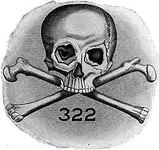Are there pirates buried at Thyatira?
Publication Salisbury Post
Date July 03, 2006
Section(s) Lifestyle
Page 0
Byline
Brief Photo:53147,left,;By Susan Shinn
Salisbury Post
"Pirates of the Caribbean: Dead Man's Chest" just might be biggest movie blockbuster of the summer.
But who needs Johnny Depp when we have pirates right here in Rowan County?
Maybe.
For years, t
By Susan Shinn
Salisbury Post
"Pirates of the Caribbean: Dead Man's Chest" just might be biggest movie blockbuster of the summer.
But who needs Johnny Depp when we have pirates right here in Rowan County?
Maybe.
For years, the legend has been told and retold about the pirates that are buried at Thyatira Presbyterian Church in Mount Ulla.
It's just a story, insists Susan Waller, a retired educator. But it's one she's told groups of schoolchildren who visited the cemetery over the years.
The story she tells is this: These four pirates decided they couldn't live their lives the way they were, so they made their way inland, to Millbridge and Thyatira Church. They married and lived respectable lives.
But one day, they were found out.
They were tried and hanged. The families begged the church to let them be buried inside the cemetery walls. In those days, thieves weren't allowed to be buried on sacred ground.
The church relented, but chiseled only skulls and crossbones in the four small markers.
"There's not a name and there's not a date, so that's the mystery," Waller says.
The pirates got a one-line sentence in James Brawley's history of Rowan County. When discussing the Thyatira cemetery, Brawley wrote: "There are two markers said to represent the burying places of pirates."
Over the years, there have been stories written about two or three markers. There are actually four there today.
The late Heath Thomas wrote a slightly different version of the pirate story in a 1961 Post article.
Thomas wrote:
"Her Majesty's Navy captured a crew of pirates on North Carolina's wild, lonely coast. They were brought ashore, tried before His Majesty's judge and sentenced to the scaffold.
"Three made their escape and headed to the frontier West -- of which then Rowan was the last outpost.
"They settled here, married and begot progeny.
"One died before the settlers knew about his past and he was given a Christian burial here at old Thyatira where the Scots organized the church about 1753.
"Later the other two of the pirate trio died, both within the year. But the whispers had come up from the coast.
"They had pillaged and murdered along the Outer Banks and the Spanish Main. They were fugitives from the scaffold.
"The dour Scots didn't want the pirates to contaminate their sacred burial ground.
"But a dead man must be buried somwhere. The congregation agreed to the burials, but on the condition that the markers carry an awful warning to the un-Godly."
Poppycock, says Gary Freeze.
(OK, maybe he didn't actually say the word "poppycock," but don't you think it sounds kinda pirate-ish?)
"Where's the ocean? Where are the waterways?" asks Freeze, a history professor at Catawba College who specializes in North Carolina history.
It's illogical that pirates would be buried in those graves, Freeze asserts.
"Piracy ended in the Atlantic in the 1720s," he says. "There's no record of anyone accused of being a pirate."
For his part in the conundrum, Freeze asked a psychic who she thought was in the graves. She told him she thought that children were buried there.
The skull and crossbones symbol has been used as a sign of disease.
But why no names, no dates?
That is a mystery, Freeze admits.
Pirates may or may not at Thyatira, but those who definitely rest inside the stone walls include Elizabeth Maxwell Steele, who gave gold and silver to Nathaniel Greene during the Revolutionary War; John and Jean Knox, great-grandparents of President John Knox Polk; Francis and Mathew Locke, early patriots; and Samuel McCorkle, Thyatira's first pastor and a founder of the University of North Carolina at Chapel Hill.
And befitting the area of the county, there are scads of Halls and Knoxes and Grahams and Steeles and Sloans.
But maybe no pirates.
"If you wanna meet pirates, go see Johnny Depp," Freeze says.
Interestingly enough, Freeze notes that the first "Pirates of the Caribbean" movie was fairly accurate in its interpretation of costumes and pirate life in general.
Still...
Go and visit Thyatira on a summer evening, when the air is cool and the sun is slowly sinking below the tall trees. Look and listen and take in the peaceful scene. Study those mysterious grave markers. You might conclude that this just may be the resting place of two, three, four pirates.
Maybe.
Contact Susan Shinn at 704-797-4289 or
sshinn@salisburypost.com.













